 |
||||||||
|
Winter 2005
|
 |
Sunset on Lake Atitlan |
I have spent New Year’s in Guatemala for so many years now it
almost seems normal. Well, no, not really. New Year’s in Guatemala
is never normal.
I flew down this year just after Christmas. Not only was it very nice
to spend Christmas at home with my family, I really didn’t want
to be in Guatemala for Christmas. As I have noted before, the Guatemalans
celebrate Christmas, New Year’s, birthdays and any other random
event they can think of with explosives of various sizes and volume.
New Year’s is bad enough, but Christmas is worse. I’ve learned
(the hard way) to avoid Christmas here.
In comparison the New Year’s celebration seems almost sane. But
not quite.
During my childhood I can recall firecrackers that were called, delicately and descriptively, “Lady Fingers.” Down here there are some called (equally descriptively) something that translates to “Lost Fingers” or “Lost Hands”. And those are the smaller ones. The larger ones, with their own awe-inspiring names, would be called bombs in any other context. More than a few people have been killed by them. I suspect the folks we’ve labeled “terrorists” nowadays would love to have even a fraction of the firepower available here on the holidays.
For the most part the Guatemalans prefer to get the biggest bang for
their buck (or Quetzal, which is the currency of Guatemala). Colorful
and complex aerial displays take a back seat to raw noise. Safety is
of no significant concern; most of the explosives, I’m sure, are
set off within a few feet of people, preferably against the side of
a building, or in a narrow street for best effect. Being a pedestrian
on New Year’s Eve is quite exciting— you have to be alert
for bottle rockets, which are more likely to be flying horizontally
than up, and at the same time keep your eyes on the ground for bombs
about to go off. It is best to just take cover, and celebrate in more
traditional ways.
An American expatriate friend here, Mike, who is truly obsessed with
the subject, says that Guatemalans spend about $1.5 million every year
on fireworks. Knowing Mike, he thinks that’s a good thing. That
figure may have crept up a little since he came to Guatemala.
Mike makes a great cup of coffee. Five years ago he moved down with his wife and two daughters to Panajachel, on the shore of Lake Atitlan, and opened up a small coffee shop, the Crossroads Cafe. He was an experienced coffee roaster, knowledgeable and exacting. He and his shop were quickly embraced by the expatriate community here, and by the travelers persistent enough to find his back-street location. He makes the best coffee in town, and probably most of Central America.
I don’t think it would be an exaggeration to say Mike is passionate
about coffee. But if you really want to see him excited, start talking
fireworks. It was just a happy coincidence, I’m sure, that he
found a place that both needed a good coffee shop, and where ridiculously
large fireworks are freely available.
At first he might have been considered a gifted amateur—the neighborhood
kids quickly learned they were outclassed when it came to faux warfare.
But recently his pyrotechnic prowess has been getting the kind of acclaim
that he has earned with his coffee-making skills.
Within minutes of my first visit to Mike’s shop this year he was
telling me about a wedding he had been hired to cater—not with
coffee, but with fireworks. Mike had his own photo album of the wedding,
featuring his handiwork, and enthusiastically described the mayhem in
great detail.
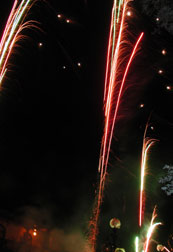 |
Then Mike told me he had been given a generous budget by a local hotel
to put on a display New Year’s Eve. He asked if I had a camera.
I should have left right then, but I’ll have to admit that a morbid
curiosity led me to accept his invitation to come with him to watch
the show, and document it as best I could.
 |
New Year's Eve 2005 |
I’ll have to say, it was quite an experience. At midnight the show began with a 30-foot long string of firecrackers which had been fortified every couple of feet with flat, triangular bombs the size of paperback books. And it quickly escalated from there. The fireworks had been set up around the pool. Mike and a couple of helpers scrambled among the sparks and smoke, lighting remarkably short fuses with matches as fast as they could go.
To his credit Mike had worked in quite a few very nice colorful and complex aerial displays. (Many of the guests of the hotel were foreigners.) But even watching those launch from just a few feet away was awe inspiring in a way that is hard to describe. It was something like being in a war zone on acid.
I took a couple dozen shots, mostly blurry streaks. Another person who had come with us took some video that did a much better job of capturing the essence of the display. Immediately afterwards, still surrounded by the smell of gunpowder, we watched the video. With a glow of pride Mike said, “Looks like Baghdad.”
_______________________________
return to top
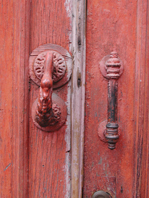 |
January 15, 2005
Quetzaltenango, Guatemala
Over the past few years I’ve written many times about the people
I’ve come to know here in Guatemala, especially my adopted family--the
five kids and their parents from the village of San Antonio Palopó,
who now live in the city of Quetzaltenango. But also their aunts (on
their mother’s side), a few others of their extended family, as
well as unrelated friends and acquaintances. I spent the first few weeks
of this trip catching up on the year past with most of them.
For the most part, everyone is doing fine. My kids are fine, and doing
pretty well in school. No one I knew died (yet), but there was a birth—and
one born a year and a half ago has been admitted to.
A Secret Revealed
Last year I heard the rumor (thanks to my kids) that Alva, one of the
aunts and a student in her last year of law school, had had a baby boy.
But my little informants didn’t know for sure. I visited Alva
at her apartment in Quetzaltenango, where she was going to university,
and saw a stroller over in one corner of her small place; there was
a partially empty bottle of Gerber baby food and a baby blanket on the
clothesline. It looked suspicious, but Alva gave me no indication that
she had a baby, and I didn’t bring it up.
This year the baby is out of the closet, so to speak. And Alva graduated
and is now a licensed lawyer. Those two things are probably related.
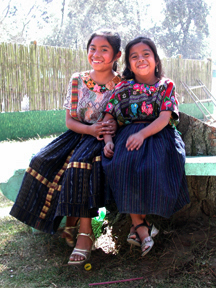 |
Yessica and Sarita |
As I’ve written before, she is the first person in her village to graduate from university, and one of the few to even attend. For years, when she was away at school, her family led people in the village to believe that she was in Guatemala City working as a maid for some rich family. As long as there was a chance that Alva might not succeed it was safer not to let on that she was trying to break out of the traditional life of the village. Failure would have brought ridicule. I suspect the secret got out in recent years; I have a hard time lying when asked a direct question.
But Alva’s baby was kept secret until she graduated. It wasn’t that she wasn’t married; under normal circumstances having a baby before marriage would have merited little, if any, comment. In the village, weddings, which cost money, are somewhat of a luxury. But having a baby while attempting to get a university education would, to the villagers, have signaled imminent defeat. Now that Alva graduated, both her education and her baby don’t need to be kept secret.
But this year there was another birth…
Another Birth, Another Mystery
Birth is always a miracle, but some are more miraculous than others. One of Alva’s sisters, Lydia, about 30 years old, is handicapped; her legs are malformed and one hand and arm is dysfunctional. But she copes fairly well. I’ve been amazed at what she can do, including tie knots in thread with her tongue which enables her to participate in the family weaving business. She is as bright as anyone I know, and is surprisingly well informed considering she has been virtually sequestered her entire life. She rarely even came out to the front room of her family’s house where she could be seen by people passing by in the street. I never saw her leave the house.
Even more surprising than being well informed—and more amazing than tying knots with her tongue—Lydia got pregnant. It is enough to make one believe in immaculate conception. As far as I know her social life was non-existent. But nonetheless, she got pregnant and he baby was born three months ago.
She left the village and moved in with my adopted family in the city of Quetzaltenango. I would like to know whether the father had to leave the village too.
When I saw Lydia and the baby a couple weeks ago she joked that miraculously he had neither mother nor father. I didn’t press her as to the identity of the latter, but I suspect it may remain a mystery, at least to me. I asked my kids, who will usually share with me any gossip they are privy to, but they don’t know.
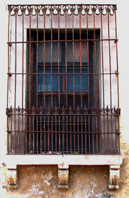 |
On the other end of the spectrum one old friend, Don Pedro, may be
near death. He is not that old, in his 40s I think, but he was one of
the first people I knew in the village. I first met his daughters when
I was a language student in Antigua. They would come down from San Antonio
to sell stuff to tourists. Sometimes Pedro would come along.
For the past couple of months he has been mostly confined to bed, and
recently in the hospital. A doctor told him that he has an internal
infection. That could mean just about any internal disorder, but probably
not an infection. Pedro said he suspected his illness may have something
to do with his past drinking habits. I wouldn’t be surprised.
Most of the time he didn’t drink at all, but when he got started
he had a hard time stopping.
When I first came to the village, about ten years ago, I rented a tiny
room from Pedro, connected to a little store the family operated. Around
Christmastime he went on a binge and stayed drunk for most of a week.
I don’t think he went home the whole time. Instead he slept in
a hammock that was hung right in front of my door. Day and night for
several days I had to step across him whenever I wanted to enter or
leave my room. He was mild mannered and quiet when he was sober, and
fortunately he was about the same when he was drunk. He mumbled and
sang, but other than that he wasn’t any trouble.
Sometimes at night Pedro’s elderly mother would come over to remonstrate
with him. She spoke only Cakchiquel, the Mayan dialect of the village,
so I don’t know what she was saying—but I have a pretty
good idea.
When Pedro finally sobered up, his daughters told him that he had borrowed
a fairly large amount of money from me to buy booze. He came to me,
haggard from his ordeal, and contritely promised he would pay me back
as soon as possible. He was so sincere, and so sorry that neither his
daughters nor I could keep from laughing. The look of relief on his
face when he realized he didn’t really owe me money was priceless.
But now, maybe the drinking is catching up with him. He was in San Antonio
when I visited the village; the doctor had let him come home for the
holidays. We talked for a while, and I left wondering whether I would
see him alive again.
The Road Ahead
The next part of my trip is going to be something completely different.
As Guatemala gets tamer and better known it is becoming harder to find
places off the beaten path. Whole busloads of tourists turn up in surprising
places. Next week I plan to head up into the Cuchamatanes Mountains,
an area I’ve never been to before. My principle destinations will
be two towns that are pretty well known; there are fairly good roads
to both of them, but few foreigners travel a shorter, but mountainous
road that connects them. That route is only a hundred miles or so long,
but it is a two or three-day journey over rough, but spectacular terrain
(from what I hear). If I run into a busload of tourists I’ll be
really annoyed.
_______________________________
return to top
February 1, 2005
Panajachel, Guatemala
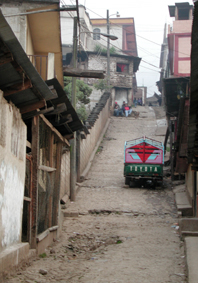 |
After spending a couple of comfortable weeks in Quetzaltenango, hanging out with my godchildren (and way too many visits to McDonalds) I decided it was time to go to some parts of Guatemala I’ve never been to before. There aren’t many, but I had never been up to the mountain village of Todos Santos, or the city of Cobán, a former center of coffee and cardamom production, which is now becoming a hub of eco-tourism. On a map the two places aren’t that far apart—a little more than a hundred miles—but the mostly unpaved road that links them winds up, down and through the Cuchumatanes Mountains. It sounded just like what I was looking for.
One reason I had put off going to Todos Santos was the climate. Todos
Santos is in a high mountain valley at about 7000 feet. Much of the
time it is blanketed in a thick, drizzly fog, which is so common that
it has a name—chipi-chipi. It is a cute name for a miserable phenomenon.
But I vowed that a little fog wouldn’t stop me this time.
From Quetzaltenango, one has to change buses in the fairly large city
of Huehuetenango, which has virtually nothing of interest to travelers
except some mediocre Mayan ruins nearby. The bus I boarded to Todos
Santos was battered and dusty. The door was broken, and some of the
windows wouldn’t close. I thought that looked promising.
From Huehue the road climbed steeply into misty mountains. Mist quickly
turned into fog so thick that I could see it drifting in through the
open door and windows. A roadside sign pointed to a vista point overlooking
the valley below, but the sign itself vanished quickly in the fog as
we passed it. As I grew colder I began wishing for a bus that wasn’t
quite so battered.
As we neared the mountaintop we abruptly broke out of the clouds into
bright sunlight. Grassy, rock-strewn fields with small flocks of sheep
gave way to rugged, pine-covered hillsides. But as we began descending
into the valley on the dirt road that leads to Todos Santos we sank
back into the fog as quickly as we had left it a few miles earlier.
Mountains and valleys disappeared, and Mayan villagers standing beside
the road took on an air of mystery.
When we reached Todos Santos the first thing I did, after finding a
place to stay, was put on nearly all the clothes I had, which I had
packed in anticipation of warm weather. It would be three days before
I was warm enough to take any layers off.
In addition to the traditional dress of its inhabitants, Todos Santos
is known for a wild horse race, held on November 1 at the end of a week
of festivities. The night before the race the riders traditionally drink
themselves silly on aguardiente, a potent beverage made from
sugar cane. The drunkenness of the contestants is an integral part of
the race and just staying on the horse is considered a real feat. There
really isn’t any other point to it. It is not uncommon for fallen
riders to be trampled to death. I’m sure there is a perfectly
good rationale for this race, but I have no idea what it is.
The Singing Dog
My first night in Todos Santos I was huddled in my tiny, cold room, reading. Outside my window a dog was barking. Down the street I could hear a man shuffling along, singing to himself. He evidently had been practicing for the pre-race party next November.
As the man passed by the dog barked at him. The man stopped, then began
singing loudly to the dog. The dog stopped barking, and began howling
along with the drunken man. Both had pretty good voices. I don’t
know whether the man was harmonizing with the dog, or the dog with the
man. But they were, indeed, harmonizing. It was pure magic. As miserable
as I was, hearing man and man’s best friend singing in harmony
made me feel like my trip to Todos Santos was worth it.
The Road to Cobán
I left town a day later, well before dawn, on a 5:30 a.m. bus, already the second bus of the day. If there is anything I like less than being cold it is getting up early. But I had been cold and half awake most of the night. There were two more buses leaving later, but I thought maybe an earlier bus might be less crowded. Not so. It was loaded to capacity and beyond, just like all the other buses here. I squeezed in among the sleepy passengers, thankful at least for their body heat.
I had expected the trip to Cobán to take three days, with overnight
stops in Sacapulas and Uspantán. But thanks to good connection
karma I made it in a day and a half, stopping in Sacapulas only long
enough to catch a bus leaving immediately for Uspantán. (I wouldn’t
have minded staying a little longer, but the next bus left about 4 a.m.
the next morning.)
Near the beginning of the trip, after I had changed buses in Huehue,
we came to a stretch of paved road and I was afraid I had delayed this
trip too long. But the pavement quickly ran out and most of the remaining
road was dirt, very rough in spots and in some places little more than
a path hacked out of the mountainside. One place we had to detour off
the dirt road, and drove down a riverbed for a ways. The water was axle
deep and steam from the hot muffler boiled up around the bus. I don’t
think there will be tour buses on that route anytime soon.
The road climbed up into the clouds, and down into fertile valleys,
past villages and towns. In some places I felt like we were stepping
into the past; houses were still made of adobe with tile roofs, rather
than the concrete block and corrugated tin that has become so pervasive
in Central America. Women knelt in front of dark doorways weaving on
backstrap looms, as women here have done for centuries.
We went down more than we went up, and the road gradually descended
toward semi-tropical Cobán. We began seeing banana and palm trees
and I started feeling more optimistic about ever being warm again.
Cobán is a nice enough city, but for travelers it is more of
a base to explore the surrounding area, which offers jungle hikes and
white-water rafting for the adventurous, inner-tube floating and hammock
dozing for the weary. But the only exploring I did was of restaurants
and shops. Faye, my partner, is coming down pretty soon and we plan
to come back and explore some of the more interesting places together
that neither of us has been to.
 |
I wasn’t quite ready to go back to familiar territory, so my dilemma was where to go next. My one criterion was that it be warm. I decided to go further eastward, towards the Caribbean coast. The most direct route would take me over some more dirt roads and past more small towns, including El Estor, on the shore of Lake Izabel. The guidebook said it was a dangerous route because of numerous hold ups and did not recommend it. I figured such a warning would keep casual travelers away, which was fine with me.
As I walked down a side street in Cobán I saw a Cobán-Estor
bus with bullet holes in the windshield, one ominously right in front
of the driver’s seat. But still, I was ready to do it. I was a
little disappointed with the lack of adventure on the road getting to
Cobán, and riding in a bus with bullet holes in it sounded adventurous.
What finally made me decide against it was learning that the bus left
at 3:00 a.m. I’ve already mentioned how little I like getting
up early. It would be really annoying to get up that early, and then
be shot at.
 |
Caribbean Condos |
But there was a longer route, paved and well traveled, which, instead of going due east, went down, around, and back up. Longer, but faster. So, with that I abandoned any expectations of adventure.
I got off the bus at a long bridge that crosses the Rio Dulce (“Sweet
River”) where a town of the same name has developed. Actually,
it is not so much a town as it is a cluster of stores, marginal hotels
and other services. To the west of the bridge is Lake Izabal; to the
right, the wide, slow river flows down to the Caribbean.
After a few nice warm nights, I took a boat down the river through the
jungle to the village of Livingston.
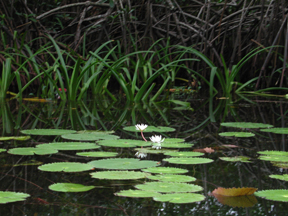 |
The Caribbean
Guatemala has relatively little exposure on the Caribbean. There are only two towns; one is a rather seedy port. The other is Livingston, surrounded by ocean and jungle, and accessible only by boat. It is so unlike the rest of Guatemala it feels like a different country.
For most of its history the majority of residents were the black Garifuna,
who have a complex and fascinating genetic heritage. (Thumbnail history:
The Garifuna are descended from Africans destined for the slave trade,
shipwrecked near the island of St. Vincent, and Amazonian Indians who
had migrated into the Caribbean basin earlier. The Garifuna were forcibly
relocated by the British to an island off the coast of Honduras in the
late 1700s, and spread out along the coast of Central America from Belize
to Nicaragua.) In Livingston during the last several years more and
more Mayas have moved in and appear to be gaining the majority.
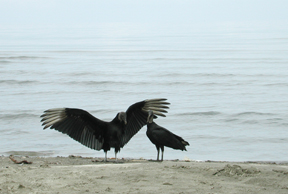 |
A beach buzzard, trying to impress his |
But in spite of the growing Mayan influence the flavor of Livingston
is still distinctly Caribbean. On the streets one hears a blend of Garifuna,
Spanish, English, and these days, Q’ekchi’, the Mayan dialect
of the region. In the street-side bars and cafés the music is
likely to be reggae or punta, an infections rhythm pounded
out on drums and turtle shells. And there is more conch soup and coconut
bread than rice, beans and tortillas.
Often in the evenings, after the lethargy of a hot steamy day, a roaming punta band will get a street party rolling. However, when I was there this time the party was rained out, so I got to bed early, and the next day I returned to the Guatemalan heartland, back to familiar territory.
_______________________________
return to top
Feb 28, 2004
Antigua, Guatemala
 |
The Arch in Antigua, probably the |
The past few weeks travels have been interesting and varied, from the
exquisite to the excruciating—sometimes both at once, such as
bouncing along over a rough road in an overcrowded bus through some
exceptionally nice scenery.
As I mentioned last time, when Faye joined me here earlier in the month
we planned to go some places we hadn’t been to before which, as
far as Guatemala goes, is a pretty short list these days. I wasn’t
sure what to expect from our itinerary other than being able to put
a few remaining places in the “been there, done that” category.
In that respect we were not surprised to cover some ground that we probably
won’t feel the need to return to. We’ve pretty much had
our fill of bumpy dirt roads and most of the little towns connected
by them, which start looking the same after a while.
But we visited other places that were beautiful and unlike anywhere
else we’ve been in Guatemala. Instead of ending this trip feeling
like we’ve done it all, we found areas we want to return to and
explore more thoroughly.
Antigua to Rio Dulce
After a couple of nights in Antigua to give Faye a chance to recover
from her overnight flight we bused it down to Rio Dulce, at the intersection
of the main highway that goes up to the jungles of northern Guatemala
and the river of the same name that connects Lake Izabal to the west
and the Caribbean to the east. The two places, Antigua and Rio Dulce,
could not be more different.
Antigua is the former colonial capitol of Central America and numerous
ruined colonial-era cathedrals attest to its rich history (as well as
to the power of earthquakes). It has long been a tourist destination,
but as things get tamer in this part of Guatemala the town seems like
it is being taken over by well-heeled tourists and fresh-faced language
students. Mayan vendors, who used to offer shopping opportunities in
the streets and in a rambling and chaotic market area, have mostly been
banished to a tidy upscale facility several blocks from the town’s
central plaza.
On the other hand, the closest Rio Dulce has to anything historical
is a faux fortress originally built in the mid-1600s to discourage Caribbean
pirates from marauding around Lake Izabal. The annoyed pirates burned
the fort not long afterward. After piracy became passé the ruined
fort was used for a while as a prison. It was restored as a tourist
attraction in the1950s.
The main feature of Rio Dulce these days is a long, modern bridge crossing
the river, reputed to be the longest in Central America. At both ends
of the bridge hastily built businesses and stores cater to highway traffic
going north and south, and river traffic going east and west. Roughly
equivalent to Antigua’s wealthy tourists, Rio Dulce attracts the
yachting crowd, of a sort. It’s not the French Riviera. While
there are certainly some nice boats anchored at the docks and in the
several small river bays near the bridge, many look like they have little
hope of leaving this third-world backwater, as do some of their owners.
After the dry, mountainous highlands, where we spend most of our time
in Guatemala, the river jungle was a nice change. It was green, warm
and moist. The rich smell of tropical decay permeates the air. The wide
river moves at a languorous pace, and so does life in general there.
We didn’t have much time around Rio Dulce this trip, but next
time we hope to spend a week or two exploring.
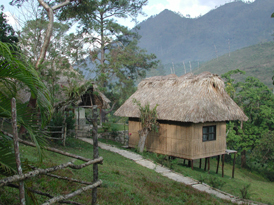 |
Jungle lodge in Lanquin |
Cobán
The main reason we went to Rio Dulce was to take a dirt road that goes west from there to the lush, semi-tropical mountains around Cobán. It seemed like a good idea at the time, but it is not a trip we intend to repeat. There are other, less painful, routes to Cobán.
In spite of the journey, or perhaps partly because of it, once we got
to where we were going we agreed that the area around Cobán was
one of the best places in the country we had ever been to. The mountains
north of there are indeed lush, softly carpeted with thick vegetation.
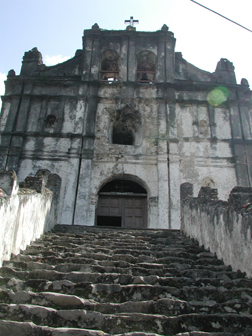 |
Colonial-era cathedral in Lanquin |
We stayed at sort of a “jungle lodge” at the edge of the
small town of Lanquin that caters to travelers. It has comfortable,
if somewhat imaginative, accommodations, as well as a kitchen that served
a variety of excellent food. (Good food, hot showers and comfortable
beds—that’s all it takes to be a big hit with travelers
like us down here.) A clean, cool river flowed by the lodge, and on
the opposite side sheep grazed on a grassy hill. It was a very idyllic
spot and another place we intend to return to.
Most people come to the area to explore some underground caves near
Lanquin, or the travertine pools of Semuc Champey. We didn’t have
enough time to visit the caves, but we did get to Semuc Champey. It
is a spectacular spot. A raging torrent of a river plunges through a
steep canyon, disappears into the ground and emerges a short distance
later to fill a cascade of calm and clear waist-deep pools. The sun-warmed
water is irresistible; we spent several hours swimming and relaxing.
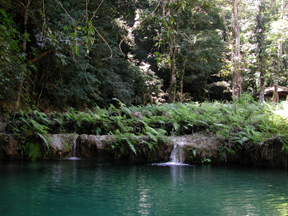 |
Semuc Champey |
On the Road Again
From Lanquin we returned for one night to Cobán, then reluctantly
continued westward over more dirt roads on our way back to the highlands
rather than taking the paved route south that would have taken us through
Guatemala City. We’ll do just about anything to avoid Guatemala
City, but in the future we’ll probably think twice about which
is worse, the city or hours of bumpy dirt roads. The scenery made it
worth doing once, but probably not again.
The last part of our trip we returned to familiar territory—Quetzaltenango,
Panajachel and finally to Antigua—to say good-bye to friends,
get some good coffee and do some last minute shopping.
On our next to last bus ride, a very crowded chicken bus to Antigua,
we were robbed by pick-pockets (as were a few other travelers on the
same bus, we learned later as we compared notes.) They didn’t
get much of value—after all, we were on the chicken bus because
we needed to economize. But it was annoying. Such small incidents remind
us we still need to be careful. Petty crime is a problem here, and there
seems to be an increasing number of highway robberies. We’re glad
we haven’t had to deal with any major incidents. But travel here
means taking the good with the bad, confident that the former outweighs
the latter.
That’s the trip for this year.
Jim & Faye
return to top
|
|
|